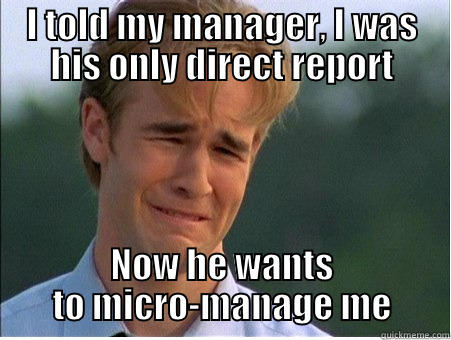 How many direct reports is the most effective for a leader? How many direct reports is the most effective for a leader? Structure your team for success with the right view of span of control, interactions and direct reports. When an organization grows beyond the one-person operator delivering goods and/or services out of their garage, the process of building systems for success becomes essential to long term health. What works as a small company has to evolve as the company grows or the organization will outgrow the preceding systems. As an organization grows, adapts, changes and evolves, one question every leader and organizational system must answer is how many direct reports any given person in a position of leadership should have. At the end of the day this question has no right answer given that each organization is unique and each manager has a different threshold for efficacy. Let’s take a look at some of the metrics, discussions and insights related to the topic of finding the right number of direct reports. Gauging interactions (energy output) How do you measure efficacy when assessing the right number of direct reports? Business Insider took a peek at the number of reports of Tim Cook, the COO made CEO of Apple, who was believed to have upwards of 17 direct reports. Hal Gregersen, Ph.D., the executive director of the MIT Leadership Center states, “It's a question of how many people a leader can have a constructive conversation with when everyone is in the same room (Lebowitz, 2015).” Time is a limited resource that every manager only has so much of and trust is the greatest asset in developing employee engagement in an organization, the question is not how thin can a leader stretch themselves but how effective they can be in leading the members of their team whether directly or indirectly. Business journals and many persons in a position of leadership (PIAPOL) site Japanese management philosophy and regard 6-7 direct reports as the maximum number that a leader can effectively manage. In his own defense, Tim Cook emailed a response to Business Insider countering that, “"If you have smart people, a strong organizational culture, and a well-defined and articulated strategy that everyone understands, you can [have] numerous direct reports because your job isn't to tell people what to do.” Whether those analyzing a leader from within the organization or from the outside agree with the direction and decisions that they make, at the end of the day they will rise or fall based upon how they approach their leadership responsibilities. Measuring span of control So much of this discussion on the optimum number of direct reports is opinion based, one metric cited by Schaffer Consulting remarks that span of control is something which can be measured in this discussion, “When a manager goes from four to five subordinates, his potential interactions with them increase from 44 to 100 over a given period; and going from seven to eight subordinates raises the total interactions from 490 to 1,080 (Inc.).” This is a classic business concept that continues to be of relevance and value to organizations such as the United States Air Force in their goal of focusing missional clarity. Size of the organization obviously comes into play and the overall structure of a team must be crafted to support it’s necessary functions as well as it’s growth goals. As for the ethereal question "What is the right span of control for a manager," a consultant Jamie Flinchbaugh blogged, "Some factors to consider are: The narrower the span of control, the more coaching at the point of activity can be done; the broader the span of control, the more the entire process can be encompassed within fewer decision makers and more aligned decisions (The Build Network, 2014).” This is a simplified means of looking at the bigger picture, but a leader must analyze the position they are in with regards to the development of their organizational structure to determine where their immediate efforts are most valuable. Does the leader need to be directly involved in the training of key share holders in the building process or do they need to take a few steps back from the process to empower those on their leadership team to take ownership for their areas of responsibility. Avoiding top heavy management If the number of direct reports is too low, because the team has built multiple layers of upper and middle management to insulate those in positions of executive leadership there is a potential for disconnect. When an organization becomes slow and top heavy by way of structure, there are too many layers to weave through in order to accomplish anything in a timely or mission centered manner. As far back as 1989, Jack Welch, the CEO credited with turning GE around, was an advocate against the six direct report rule for many of these reasons. In an interview with Harvard Business Review, the management guru shared his candid thoughts on the matter, “We took out management layers. Remember the theory that a manager should have no more than 6 or 7 direct reports? I say the right number is closer to 10 or 15. This way you have no choice but to let people flex their muscles, let them grow and mature. The leader can focus only on the big important issues, not on minutiae (Tichy & Charan, 1989).” Systems should be built to support the people in the field who are making the products and/or delivering the services that make up the core functions of the organizations value interaction with the market. The question of the right number of direct reports is not a matter of ego nor strictly of science, but rather is a key discussion that will evolve with the needs of the organization in a manner that is unique to that team. Mike Myatt, Forbes contributor and chairman of N2 Growth, shares, “Where many leaders become disoriented is by confusing platform with people, and position with responsibility. Here’s the thing – it’s not about the platform, it’s about the people. Without the people there is no platform, and ultimately nothing to lead. It’s not about you (the leader), but what you can create and influence through those you lead (Myatt, 2012).” Rather than looking for the perfect number of direct reports, a leader should ask how many people they can effectively support to keep the vision and mission of the organization moving forward with relationship to the team’s values. Clarity. Consistency. Accountability. References: Lebowitz, S. (July 8, 2015) Apple CEO Tim Cook now has 17 direct reports – and that’s probably too many. Business Insider. Retrieved from http://www.businessinsider.com/apple-ceo-tim-cook-has-too-many-direct-reports-2015-7 The Build Network (April 3, 2014) Wait, how many reports direct reports did you say you have? Inc. Magazine. Retrieved from https://www.inc.com/the-build-network/direct-report-challenges.html Tichy,N., Charan, R. (October 1989) Speed, simplicity, self-confidence: An interview with Jack Welch. Harvard Business Review. Retrieved from https://hbr.org/1989/09/speed-simplicity-self-confidence-an-interview-with-jack-welch Myatt, M. (November 5, 2012) Span of control – 5 things every leader should know. Forbes. Retrieved from https://www.forbes.com/sites/mikemyatt/2012/11/05/span-of-control-5-things-every-leader-should-know/#7f921b0328c8
0 Comments
 "If we don't battle to the death, they will kill us both" "If we don't battle to the death, they will kill us both" Originally published as The Cause, Cost and Countermeasure to Conflict in an Organization in The Project Management Times By Jon Isaacson If you have dysfunction in your team, the cost may be higher than you want to admit but the cure may also be closer than you realize. Frustration in the workplace, does such a thing exist? In a recent article in Forbes magazine, researchers discussed the primary sources of disgruntlement within organizations. According to the study, most employees noted that they were frustrated by personality differences and incompetence in their co-workers. This is not news to anyone who has worked in an organizational setting, one human plus one human will eventually equal conflict. The potential for conflict, as well as the intensity and duration, are compounded by the number of humans added to the equation. More people, more problems. What is interesting about the Forbes article is that upon further investigation there was an underlying source which contributed to the environment of dysfunction, “In fact, teams having conflict had much higher levels of ambiguity in three categories of work: their team’s goals, roles, and procedures. So, while it is very human to assign personal motive and blame in times of trouble, there isn’t really anything personal about the core of workplace conflict. If you back up and look at the facts, a lack of clarity is what’s truly to blame.” (Wakeman, 2015) The need for clarity is foundational to functionality and trust within an organization. Where there is a lack of clarity, there will be conflict. Office drama is costly, CPP Inc. performed a study in 2008 which discovered that employees in the United States spent 2.8 hours per week dealing with conflict which CPP estimated as costing over $359 billion in paid hours or the equivalent of 385 million working days (Lawler, 2010). Every business understands the need to watch the bottom line, so why are mangers unwilling to recognize the high cost of conflict? Think of it, if every employee in your office could increase engagement and efficiency by 7% by only changing one element, wouldn’t that be something a wise leader would be more intentional about? Recognize the cost of inaction. Managers spend much of their time putting out fires, and yet our discussion to this point has demonstrated that the cure for dysfunction may be closer that you think. By understanding the cost of conflict, we recognize the value of investing in practices that will help our organization to identify and address these hot beds of discordance within our teams. Realize the need to eliminate the blame game. When employees focus on blaming each other, too often managers are happy to allow them to target their ire upon each other rather than dealing with the core of these issues which creates a negatively recurring cycle. As noted by the author in a prior article - how leaders respond to conflicts can either reinforce cultural values that strengthen the team, or they can respond in ways that destroy morale (Isaacson, 2016). Reduce conflict by creating clarity. If the research from Wakeman and her team as outlined in Forbes is accurate, then leaders can make a significant reduction in interpersonal conflict by being more intentional about organizational clarity. As a leader, you can alleviate friction between team members by being more clear about team goals, roles, and procedures as quoted above. If we can sense the frustration in the organization and we can calculate the deep costs, we should be proactive in working towards long-term solutions. Often inaction is caused by an inability to identify the causes or formulate an effective plan, but now that these have been brought to light the only question left is whether we will be intentional about getting into the mix to make the magic happen. There are no shortcuts when working with interpersonal dynamics but progress is attainable through the countermeasures for the conflict we have discussed. References Wakeman, Cy (2015, June 22) The number 1 source of workplace conflict, and how to avoid it. Forbes. Retrieved fromhttp://www.forbes.com/sites/cywakeman/2015/06/22/the-1-source-of-workplace-conflict-and-how-to-avoid-it/#32a27f89126e Lawler, Jennifer (2010, June 21) The real cost of workplace conflict. Entrepreneur. Retrieved fromhttps://www.entrepreneur.com/article/207196 Isaacson, Jon (2016, July 11) Eliminating blame in your organization. Retrieved from http://izvents.weebly.com/words/eliminating-blame-in-your-organization  Can't we all just get along? Can't we all just get along? Originally published as Shared Spaces: Shaking Up The Restoration In-Office Experience February 24, 2016 by Restoration & Remediation Magazine (R&R) By Jon Isaacson Could restoration companies benefit from a non-traditional work space? I started my career in property restoration in a shared office with myself, my manager and space designated for our crew to meet and interact. At most places I have worked since, the more normative office is laid out in designated segments of isolation. While I don't dismiss the value of personal space and enjoy my privacy as much as anyone, I have found the value of shared spaced and have worked to create open work space in every team that I have supervised. Shared Space Equals Shared Experiences When you share an office, you can feel the pulse of the team. You hear your team, even when you are not conversing with them directly, you are hearing their interactions. While there are times when the noise level has to be managed, when you hire people who are respectful they will likely already understand the dynamics of time and place in an open space. For our teams the benefits of a communal office within our department has far outweighed the perceived negatives. Imposing an open office on people who are not ready for it is a recipe for disaster. Transitioning to a shared space is made much more seamless when you have people who enjoy working together and/or you hire people who understand the culture. Implementing an open office is not of any benefit if it does not reflect your culture or add value to your team. Open Space Equals Open Communication Creating a shared space has allowed us to more readily share information at all levels of our department. Having our crew come into our office in the morning creates a natural opportunity to discuss the day's assignments. When the crew returns in the evening, we can debrief and discuss needs for the following day. These organic connection points throughout the day have increased our interactions at professional and personal levels. Combining our open space with making our workloads visible has helped us to elevate our clarity across our team interactions. Your office is your second home. Arguably, you spend more time in your work space with your work peeps than with your actual family, so making it an enjoyable and functional environment should be a priority. When drafting the plan for your work space - whether open, traditional or some other system with a fancy name - think about the following:
For our department, we have hired people who bring value to the team, we have been protective of the culture that we have developed and we have enjoyed the benefits of a shared work space.  Creating a good working environment is not an easy task but it should be the goal for any company that wants to remain competitive in the current market where finding good people is often more difficult than finding good customers. When we reached out to multiple leaders across various industries, we found one ingredient that is key to developing a team that operates in the positive margins of employee engagement is the simple art of listening. Danny Morgan, who is a store manager for a national retailer in Eugene, Oregon, shared, “I can tell you it’s not about the money no matter what they say, we all work for the money but it’s not about the money – ain’t about the fetti.” So it if isn’t about the money, what can leaders do to ensure they are communicating to their employees that they are invested in them as people? Mr. Morgan told us, “Every moment to listen, every second of praise and every time letting them know that they can come to you with anything knowing that you will provide a positive spin or reaction.” Listening to team members shows them that they are worth our time and that we care to hear what they have to say. Employees may not always come to you when it’s convenient, but it is important to remember to make time for them as what they share may not seem important but it could be critical to them. Fire fighters know a thing or two about building a team. Team work is important to all professions, but it is critical when a group must band together to respond to life and death scenarios. Coy Morris, who fights fires with his team near Seattle, Washington, notes that, “Finding the common goal(s) amongst you and your team. Which in and of itself demands open and safe conversation.” Who initiates the process of establishing common goals and building a culture of open communication? For Mr. Morris, “I think the organization sets the mission, the team balances objectives with reality, but I think it starts with management.” Even though fire-fighting is dangerous, this alone is not enough to forge individuals into a strong team as there are plenty of dysfunctional teams that work in high pressure situations. Many of these teams are able to pull it together when necessary but how much more positive would the environment be if they were able to function cohesively? Danny Morgan reminds us that building respect goes both ways, from leaders to and from employees, “One important thing [to remember] is it takes time, one day at a time.” Tom Los who leads a team for a local government entity in Moses Lake, Washington notes that listening can bring engagement as well as new opportunities for the organization, “I listen to my staff and then give them projects and tasks which mixes their job up. They really enjoy it. If someone has an idea, I try to embrace it as much as possible and let them do it.” When those in a position of leadership fail to listen they may be holding the team back from sharing ideas that could solve problems or push the organization forward. Service industries are built upon the strength of their team members to work together to carry the values of the organization through consistently on every project. Denis Beaulieu who operates in project management leading property restoration and abatement teams in Moorpark, California echoes the importance of listening, “Making sure that they are heard when asked. Have their ideas mean something and not just ask for an opinion or suggestion but try them and see if they work. Don’t discount anyone’s ideas or make yours more important.” As noted by many that we interviewed, the catchwords and principles we hear from business leadership books go only as far as we are willing to apply them in our teams. What we want to know from real people who are practicing team work, leadership and developing organizations that operate on their values, is how they flesh out these principles in their day to day lives. Denis builds upon his comments from before regarding listening, “Empower people. They feel more a part of the organization when they feel they are part of it and not just working for it. Most important people want to feel they belong.” To be successful in a position of leadership, individuals must remember where they came from, what they desired while they were in the trenches and serve as an intermediary between the makers of decisions (the suits) and the daily decision makers (those in the field). Rex Fox who serves in the leadership team for a credit union based out of Eugene, Oregon, outlines a few key touch points relevant to listening, “Be approachable. Learn about the staff and what is important to them. Be trustworthy and trust your staff (but inspect). Roll up your sleeves and help when needed, but don’t do their jobs for them.” Rex brings up a great point that when we roll up our sleeves and get our hands dirty being shoulder to shoulder with our team members there is an organic exchange between individuals that cannot be built any other way. Listening provides a means to blur the lines between management and employees that often holds a company back from reaching it’s potential. When a person in a position of leadership takes the time to listen, they remind themselves and the whole team that we are all in this together. Much can be learned about individuals, teams, issues and opportunities by simply taking a moment to hear and receive input from those who are investing in the team, the customers and the culture. Please note this is one segment in a series related to creating a good working environment based upon brief interviews that we conducted with multiple professionals across various industries, leadership roles and viewpoints on the topic. Stay tuned for more. Shoot us an email or comment if you have something to say on this as well. |
AuthorThoughts on personal and professional development. Jon Isaacson, The Intentional Restorer, is a contractor, author, and host of The DYOJO Podcast. The goal of The DYOJO is to help growth-minded restoration professionals shorten their DANG learning curve for personal and professional development. You can watch The DYOJO Podcast on YouTube on Thursdays or listen on your favorite podcast platform.
Archives
March 2023
Categories
All
<script type="text/javascript" src="//downloads.mailchimp.com/js/signup-forms/popup/unique-methods/embed.js" data-dojo-config="usePlainJson: true, isDebug: false"></script><script type="text/javascript">window.dojoRequire(["mojo/signup-forms/Loader"], function(L) { L.start({"baseUrl":"mc.us5.list-manage.com","uuid":"b9016446bd3c6a9f0bd835d4e","lid":"83282ffb9e","uniqueMethods":true}) })</script>
|
Jon Isaacson |
Connect. Collaborate. Conquer.
© COPYRIGHT 2015. ALL RIGHTS RESERVED.
|



 RSS Feed
RSS Feed